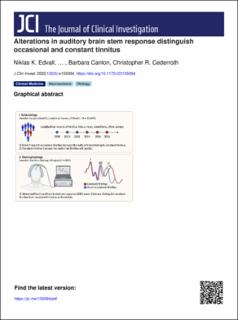| dc.contributor.author | Edvall, Niklas K. | |
| dc.contributor.author | Mehraei, Golbarg | |
| dc.contributor.author | Claeson, Martin | |
| dc.contributor.author | Lazar, Andra | |
| dc.contributor.author | Bulla, Jan | |
| dc.contributor.author | Leineweber, Constanze | |
| dc.contributor.author | Uhlén, Inger | |
| dc.contributor.author | Canlon, Barbara | |
| dc.contributor.author | Cederroth, Christopher R. | |
| dc.date.accessioned | 2023-03-22T12:09:53Z | |
| dc.date.available | 2023-03-22T12:09:53Z | |
| dc.date.created | 2022-05-25T11:02:03Z | |
| dc.date.issued | 2022 | |
| dc.identifier.issn | 0021-9738 | |
| dc.identifier.uri | https://hdl.handle.net/11250/3059836 | |
| dc.description.abstract | BACKGROUND. The heterogeneity of tinnitus is thought to underlie the lack of objective diagnostic measures.
METHODS. Longitudinal data from 20,349 participants of the Swedish Longitudinal Occupational Survey of Health (SLOSH) cohort from 2008 to 2018 were used to understand the dynamics of transition between occasional and constant tinnitus. The second part of the study included electrophysiological data from 405 participants of the Swedish Tinnitus Outreach Project (STOP) cohort.
RESULTS. We determined that with increasing frequency of the occasional perception of self-reported tinnitus, the odds of reporting constant tinnitus after 2 years increases from 5.62 (95% CI, 4.83–6.55) for previous tinnitus (sometimes) to 29.74 (4.82–6.55) for previous tinnitus (often). When previous tinnitus was reported to be constant, the odds of reporting it as constant after 2 years rose to 603.02 (524.74–692.98), suggesting that once transitioned to constant tinnitus, the likelihood of tinnitus to persist was much greater. Auditory brain stem responses (ABRs) from subjects reporting nontinnitus (controls), occasional tinnitus, and constant tinnitus show that wave V latency increased in constant tinnitus when compared with occasional tinnitus or nontinnitus. The ABR from occasional tinnitus was indistinguishable from that of the nontinnitus controls.
CONCLUSIONS. Our results support the hypothesis that the transition from occasional to constant tinnitus is accompanied by neuronal changes in the midbrain leading to a persisting tinnitus, which is then less likely to remit. | en_US |
| dc.language.iso | eng | en_US |
| dc.publisher | American Society for Clinical Investigation | en_US |
| dc.rights | Navngivelse 4.0 Internasjonal | * |
| dc.rights.uri | http://creativecommons.org/licenses/by/4.0/deed.no | * |
| dc.title | Alterations in auditory brain stem response distinguish occasional and constant tinnitus | en_US |
| dc.type | Journal article | en_US |
| dc.type | Peer reviewed | en_US |
| dc.description.version | publishedVersion | en_US |
| dc.rights.holder | Copyright 2022 The Author(s) | en_US |
| dc.source.articlenumber | e155094 | en_US |
| cristin.ispublished | true | |
| cristin.fulltext | original | |
| cristin.qualitycode | 2 | |
| dc.identifier.doi | 10.1172/JCI155094 | |
| dc.identifier.cristin | 2027279 | |
| dc.source.journal | Journal of Clinical Investigation | en_US |
| dc.relation.project | EC/H2020/GNP-182 | en_US |
| dc.relation.project | Norges forskningsråd: 299864 | en_US |
| dc.identifier.citation | Journal of Clinical Investigation. 2022, 132 (5), e155094. | en_US |
| dc.source.volume | 132 | en_US |
| dc.source.issue | 5 | en_US |

